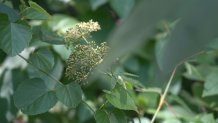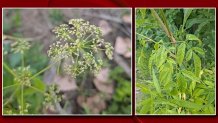Brett Johnson, Sr. Environmental Coordinator/Urban Biologist with Dallas Parks and Recreation Department tells NBC 5 about the dangers of water hemlock, found near White Rock Lake, and what the parks department is doing to get rid of it.
The Dallas Parks and Recreation Department is applying an herbicide Friday around White Rock Lake to kill what the USDA describes as "the most violently toxic plant that grows in North America."
The city said late Thursday afternoon that park staff was told that invasive water hemlock was growing in several areas around the lakefront in places where the plant could accidentally come into contact with people or animals.
Watch NBC 5 free wherever you are
Park visitors are advised to be aware of the plant and the serious danger it poses. The plant contains the toxin cicutoxin, which acts directly on the central nervous system and is a violent convulsant.
Symptoms can appear in as little as 10 minutes. Primary methods for poisoning are ingestion, however, skin contact may also cause a reaction and any person who contacts water hemlock is advised to call poison control immediately at 1-800-222-1222.
Get top local stories delivered to you every morning with NBC DFW's News Headlines newsletter.
The USDA warns only a small amount of the toxin found in water hemlock can lead to grand mal seizures and death and that the toxic substances found in the plant react very quickly, often too quickly for medical treatment to be effective.
The plant is inconspicuous and can grow from about 1.5 to 3 feet tall and sprouts small clusters of white flowers in an umbrella formation. The leaves are long and thin and lead to notches, not tips.
"The plant may resemble common yarrow or cow parsnip that are also in the carrot/parsley family," the city said.
Removing the plant is deemed an urgent priority. The USDA recommends spraying or grubbing the plant and, if grubbed, all plant material should be burned.

Brett Johnson, Sr. Environmental Coordinator/Urban Biologist with Dallas Parks and Recreation Department told NBC 5 Friday afternoon the hemlock was reported by a community scientist who spotted it.
Local
The latest news from around North Texas.
Johnson said Friday they have found several clusters of the plant and that hand pulling or mowing them posed too great a risk so they decided to treat them chemically with an herbicide.
Johnson added that they will spot treat for the plant and will not be broadcasting the herbicide over a large area. The city said Thursday that a licensed Texas Department of Agriculture applicator will treat the areas along the lakefront Friday with Rodeo (glyphosate), an herbicide that the city said will dry up the plant and kill the roots, neutralizing any toxicity and threat to human health.
Johnson reiterated that as long as parkgoers are not eating or touching the plant, it's shouldn't pose a problem. He added that the clusters they've found are in unmaintained areas close to the water.
Johnson said water hemlock was found near the lake 10-12 years ago and was treated and removed.
Water hemlock is not native to Texas, but Johnson said it is considered a naturalized species. According to the USDA, the invasive plant is more common in the Western United States and "is commonly found in wet meadows and pastures and along the banks of streams. It starts growing in the spring. In the higher elevations, water hemlock flowers in June or July."




